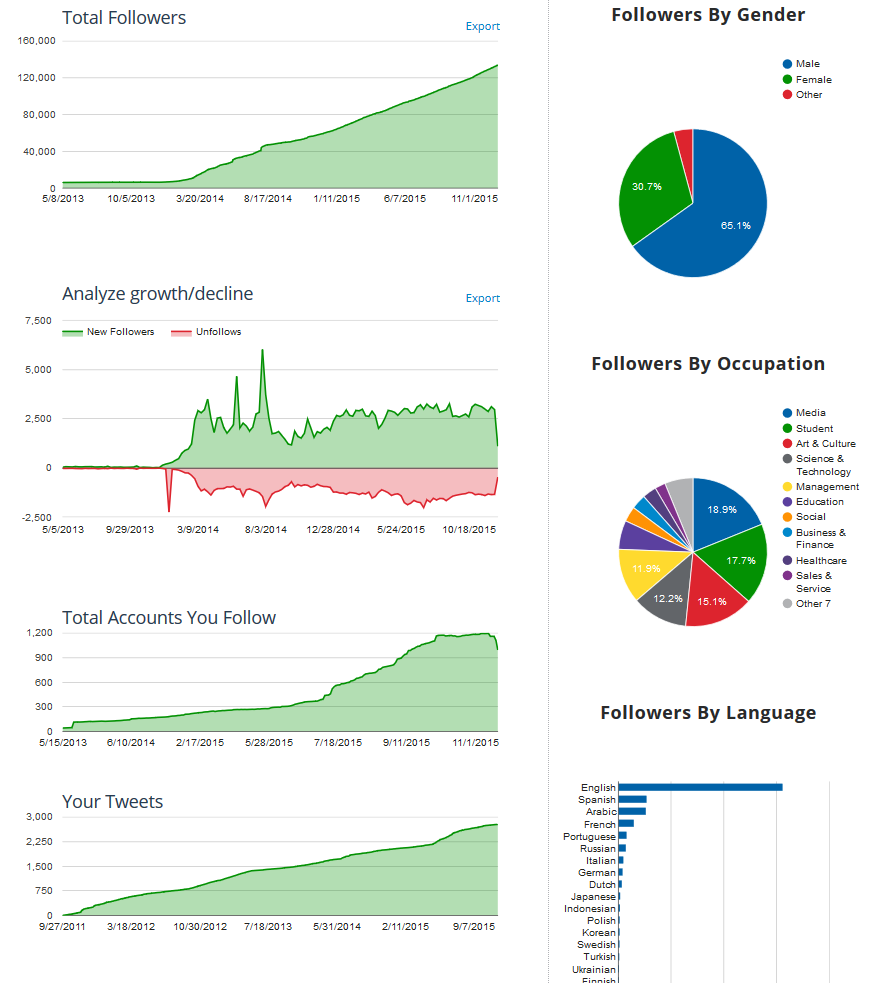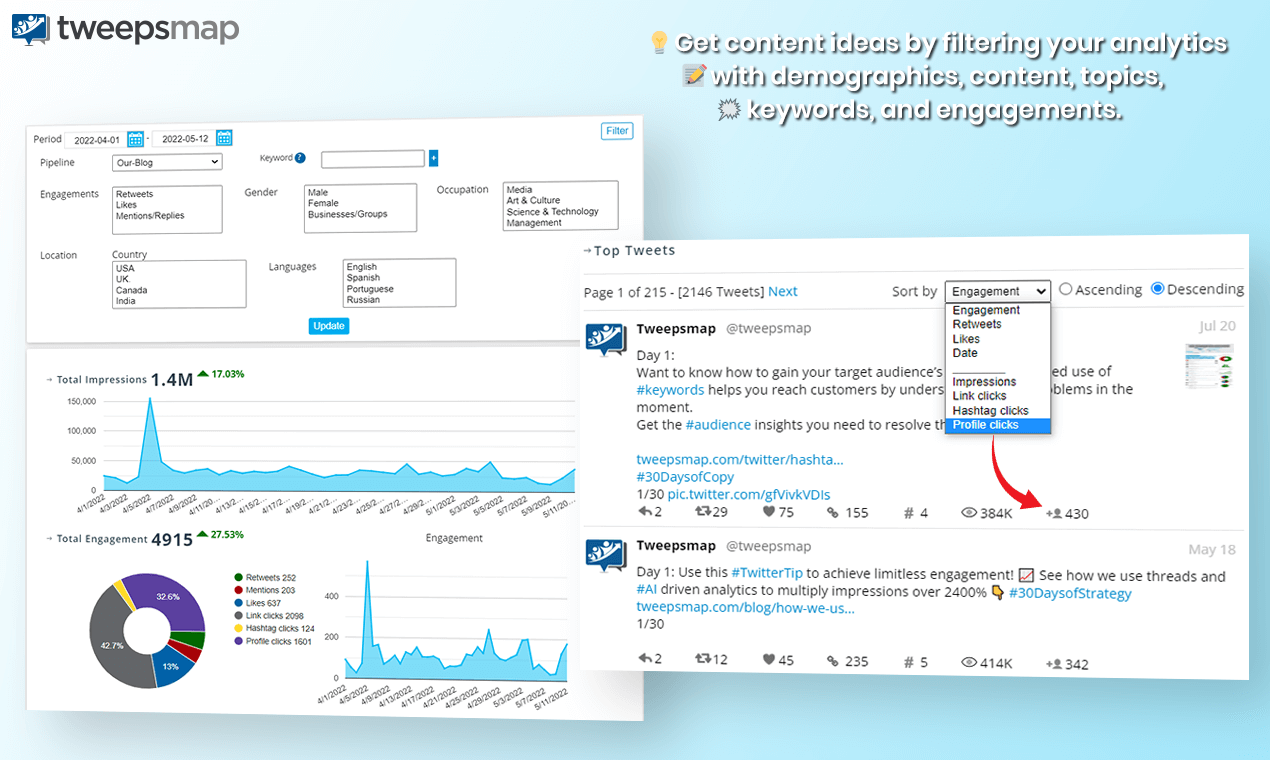As of 2022, 10 million blog posts are published daily – an increase of 8 million over the past 10 years.
As scary as this number seems, you may ask “how to get people to read my blog?”
You can do it by:
- Creating a clear structure in each post and
- Using your X (formerly Twitter) followers’ insights to tell you what topic they want to read.
Table of Contents:
Best Blog Post Structure
The average blog post has around 1000 words; however, readers usually skim over a page to see whether it is worth reading or not. In other words, they usually don’t read the whole thing.
People read blogs to find specific answers to specific questions related to specific topics. When they can’t find what they are looking for in a timely manner, they leave.
For that reason, a clear and defined structure helps readers find what they need efficiently.
The Benefits of Having a Blog Structure
Having a blog structure allows readers to easily navigate your page and quickly find whatever information they need. As a result, when readers know that your blog is user-friendly, they are more likely to come back.
The key to having people read your blog is to make it retrievable. Having a structure makes search engines recognize it as having friendly search engine optimization (SEO).
Blog Basics and Structure Examples
There are 4 essential components to a blog structure:
1. Title
It must be concise and relevant to the post’s main topic. It’s the only way for your readers to know what to expect when clicking on one of your posts.
It should also be captivating to make readers want to click on it.
Think of it as a book cover. I know we often say, “don’t judge a book by its cover,” but realistically, we still do it.
It can also be seen as an ad for your content as you try to convince your audience that your post has the ultimate answer to everything it needs.

Here are a few tips on how to write an effective title:
-
-
-
- Make it short and straight to the point: Your title should only give readers an expectation, not the takeaways of your post.
- Be clear about why they should read it: Emphasize on the benefits of reading your post! Your title should state what your readers can get out of clicking on your page.
- Example: Boost Your Engagement Rate on X with Ai-Powered X Analytics
- Announce exciting news: When talking about your company’s products and services, make sure to talk about it in a way that will attract potential customers and followers. You can do it by introducing new features, discounts, or advice on how to get the most out of your product.
- Example: Finally, You Can Now Schedule Threads on X!
- Show your readers that your post has everything they need: Even if the internet already has the answers to many questions that your readers are asking themselves, it’s more convenient for them to have everything in one place. Your title should reflect that your post is THE one with all the information.
- Example: A Definitive Guide to Writing a Blog That Your Followers Will Read
- Question titles: If you’re going to make your title a question, make sure that it is something that your follower base truly wants to know.
- Example: Great Blog Content But No Opens? It’s Probably Your Headline!
- Show your reader that they will learn something: The most common way to do so is to use “how to” headlines.
- Tell your readers what to do: If you’re trying to sell a product or an idea, tell your audience what they have to do. That way, they will wonder why they should do so, and it will intrigue them enough to click on your post.
- Example: Don’t Auto DM Your Followers, Converse With Them Instead
- Use numbers: Rather than writing a number in a word format, use digits instead. You can also add parentheses or square brackets to make your title stand out.
- Examples:
- 3 Best Practices for Better Video Marketing
- X Audit Like a Pro (+4 Methods Marketers Overlook!)
- Examples:
-
-
There’s more than just a title to get your followers to read your post. You also need an attention-grabbing and clear introduction.
2. Introduction
Your title motivates potential readers to click on your post, whereas your introduction motivates them to read it.
For that reason, it is essential that you make it interesting.
I know that it’s easier said than done and that everyone has different tastes, but here are a few pieces of advice that have been shown to motivate readers to read more into your post:
-
-
- Call attention to a problem: Often, people read content for the value it offers. That said, if your introduction points out an issue that your post offers the solution to, you catch their attention. It shows that you understand their struggle and that you have all the information they need to fix it.
- Give expectations: It is essential to give expectations to your reader about what they are going to get out of reading your post. You need to state what will be covered so that they can find whatever information they are looking for rapidly.
- Explain the benefits: This aims to motivate the readers to learn something that will make their lives better, and that will give them positive results.
- Ask a question: The purpose of your question is to make them reflect and want the answer to it, which they should find the remainder of your content. You could also formulate it as a rhetorical question, meaning that the answer is obvious.
- Example: Are you tired of spending countless hours on a blog post without any follower engagement?
- Challenge a long-held belief: Often, a confrontational introduction will either have readers agree, disagree, or wonder why you are opposing a topic. In return, they will want to learn more about what pushes you to think that way. This helps engage an audience as people live for drama and conflict.
- Use a quote: Quotes can be used for many reasons, including displaying credibility, creating a captivating opening, backing up your thesis, and providing a framework to your post. It can also summarize a standard belief and make up a counterargument. However, you should watch out for mainstream quotes.
-
Why introduce something you won’t talk about? This leads to my next point – the body.
3. Body
Your body should follow a logical sequence of ideas, like how the title and introduction come before the body and the conclusion.
Its content should be explicit – clear, and detailed, leaving no room for confusion or doubt. Or else your audience will leave with the feeling that they haven’t learned anything. This can be done by shortening your paragraphs and avoiding fancy formal words that few people truly understand.
However, beyond that, it should be tailored to your audience and what they are interested in.
Here are a few pieces of advice to help you write your body:
-
-
- Write the same way you talk: I know it seems odd to write informational pieces in the first person, but it’s one of the main ways you can stand out from other bloggers.
- Introduce the following subheading: It’s important to keep a certain flow in your body and to make it smooth. You can do this by introducing your next subheading, as it will make people want to read more. Also, readers won’t feel like there is missing information, just like in a conclusion.
- Include personal stories: Try to include personal stories as examples to support any information that you’re giving! It makes it more interesting for your readers while helping them retain information better. It also allows them to relate to your reality and/or understand that their struggle is normal. However, keep it short and stick to the point.
- Get rid of unnecessary words: Why say more than you need to and discourage your readers?
-
Some people fly over a post, but some just skip right over to the conclusion. For that reason, take a couple of minutes and write one so no matter how much time someone gives you reading your blog, they can leave with something to take away.
4. Conclusion
Why summarize the information if your readers have read your content?
Well, for the same reason, you wouldn’t say hello without waving goodbye – it leaves people feeling like the interaction is incomplete.
Also, many are busy and want to find information quickly by simply flying over your page. For that reason, your conclusion and key takeaways are vital for making your point.
Here are the top strategies for writing a conclusion that will leave your readers eager to read more of your posts:
-
-
- Wrap-up your content: Offer your audience a little refresher of what they learned by stating the key takeaways from your post. This will recall some of the information and help them remember more. That way, if they feel that they have learned something, they are more likely to come back and read more of your content.
- Use a call to action (CTA): A call to action aims to stimulate your readers to do something to deal with a given problem, like not having your followers read your blog. Making it extremely easy for them to find resources they can benefit from is a win-win for everyone.
- Example: Click here to try our filterable X analytics!
- Image-based CTAs and buttons are sometimes more attractive than traditional CTAs – especially for readers that tend to skip conclusions.
- Ask a question: Just like in the introduction, asking a question aims to provoke your readers’ interest and engagement. In the case of a conclusion, your goal should be to make your readers talk and reflect on it.
- Use a cliffhanger: Nothing is more frustrating than finishing a book, movie, or TV show, and it says, “to be continued.” Yet, you still come back for the sequel because you can’t stand the uncertainty of what is going to happen next. That said, the same thing applies to blogs. You must make your readers want to come back for your next post.
- Tease your readers: The first Avatar movie came out over 10 years ago, and most people forgot about it until they teased the second one, which made the entire world eager to see the sequel. You should do the same thing with your blog – show your audience a snippet of what is upcoming. This helps with generating excitement among your audience and making them impatient to learn more.
-
It’s not only your title, introduction, body, and conclusion that will determine whether your post is well structured.
You could have a bunch of valuable information in your blog, but it’ll lose its value if you don’t add a little cherry on top.
Additional Elements and Tips
Most blogs follow the same basic structure; however, you need to go the extra mile to stand out.
There are several ways to make your blog structure more tailored to what you are trying to sell – whether it be an idea, a product, or a service.

Use Headings and Subheadings
If you’re anything like me, you skim through a blog post and look for headers, and if there aren’t any, you leave.
That’s where headings and subheadings save the day.
They allow readers to refer to the points they are most interested in and to retain the main elements of the post.
By quickly skimming this post, you already get the key takeaways and the components to include in your blog.
Do you know what is as discouraging as a page with a bunch of words and no headers? An endless paragraph, which leads me to my next point.
Shorten Your Paragraphs as Much as Possible
Blogs are not supposed to be a memoir; rather, they should be as short as possible to make it easier to skim through.
Personally, I get discouraged when reading an endless paragraph and end up avoiding it. However, by ignoring it, there is a good chance of me missing out on a bunch of valuable information.
As a writer, you don’t want your hard work to go to waste, and one way to avoid that is to keep it short and straight to the point.
The goal of shortening your paragraphs is also to make them more comprehensible, but there’s no point if what you’re saying doesn’t make sense.
Avoid Fancy and Formal Words
As I said, your content needs to be explicit and understandable – especially when it comes to English.
English is a world language, so people from all around the globe use it. Yet, it doesn’t mean that everyone understands it fluently.
For anyone, it’s irritating to read something and not understand a given word and then having to look it up.
It’s nearly impossible to avoid that completely; however, by using standard words and phrases, you can make your blog fun and get the point across.
It also allows people to better understand what you’re trying to say.
For example, journalists don’t use fancy medical terms that nobody understands to talk about Covid. Their goal is to inform the population, not just medical workers.
Don’t Worry About the Length
Would you rather read a post that is shorter, but with less information or one that is longer but that has everything you’re looking for?
If your post is well-organized and structured with headers, you’re good to go!
A longer post dives deeper into its topics and gives readers the chance to learn better.
Search engines also love lengthier content because they recognize that it has more information and that it’ll give more value to readers.
Sometimes, it may feel pointless to explain something that seems obvious or that can be found in other readings; however, you shouldn’t assume that all your readers have that knowledge.
That said, don’t be scared to repeat things.
Don’t Be Scared to Repeat Things
In a perfect world, your readers would read every single post that you publish. Unfortunately, it isn’t the case.
For that reason, you shouldn’t hold yourself back from discussing something that you’ve talked about in other posts. If anything, you should reference it to attract new readers from navigating deeper into your page.
There is also no need to be uncomfortable repeating information that you have previously mentioned in the same post. Regardless, most readers won’t go through the whole post; rather, they will just jump to specific sections.
A way you can repeat things without them seeming redundant is to use images, which allow for other benefits as well.
Use Images
Images are known to help with one’s attention span.
They break down a post and make it appear lighter and more stimulating.
Just make sure that the images relate to your content and that they’re used properly and in an appropriate context.
Put More Information Than Others
On the internet, it’s easy to find pages about how to structure your blog and how to make it engaging; however, it is not as common to come across an “all-in-one” guide.
That said, go above and beyond in your research so that your audience will have all the information they need at once.
This will allow them to save time rather than having to read multiple posts instead of one.
How to Make a Blog People Will Read
Now that you have a clear understanding of how to properly structure your blog in a way that your audience will be able to navigate it easily while having fun, you need to know how to make it engaging.
Typically, a blog is informal and meant to be a fun read, so your readers should feel like they are having a conversation with you.
The purpose is to build a loyal relationship with your follower base.
In return, they will be more likely to come back to your blog and talk about it to others.

Tailor Your Blog to Your Audience
Your audience will not read your post if it doesn’t relate to them personally.
For example, you wouldn’t post about retirement homes if most of your follower base is between 18-25 years old.
To avoid making such mistakes, you need to draw a portrait of your audience and what their interests are.
You can do this using Fedica, an AI-driven analytics and management tool that allows you to map your followers and see what are their interests and sentiments.
Our tools also aim to give you a picture of who you’re creating content for to make sure that you reach the right segment of your followers by giving you information such as their gender and occupation.
Would you write about arts if your followers are mostly construction workers? Yes, they may be interested in arts as a hobby, but you might want to think twice about it before doing so…

Our platform’s intelligent publishing makes it easy to examine what your audience really likes!
It shows you the trending topics according to your followers’ location, their interests, and the tweets of your most influential followers, among other things.
This engagement dashboard allows you to see what kind of content your followers enjoy the most and that performs best.
To tailor your blog to your audience easily with tools like Fedica, you need some sort of social media presence.
Use Social Media
It’s frustrating when you spend countless hours and put in lots of effort into a post that doesn’t get high engagement; however, there’s an easy way you can avoid that – social media.
Social media platforms such as X and many others have been used for self-promotion for several years now.
Plus, you can learn more about your audience with Fedica’s engagement dashboard. Our tool shows you what content performs the best, which lets you continuously create Tweets that get more and more engagement.
Another of the platform’s features is the ability to schedule automatic posts from any RSS feed. This is a way for you to connect your blog to the Fedica pipeline and have it automatically post fresh content from it without spending the extra effort!
But everything is good in moderation.
There is a very fine line between the right amount of posting and too much on social media, which you should be aware of.
If you post too much, you might overwhelm your followers, which is something you want to avoid.
For that reason, you need to be consistent because there is a difference between posting too much and posting frequently, just like with blogs.

Be Consistent
As much as it’s good to cover a variety of topics, your readers will follow you because you focus on a specific topic or field, like Software and Technology.
That said, talking about Fitness in a such blog won’t attract most of your followers. Oppositely, it might even push them away because it simply doesn’t correspond to their interests anymore or why they initially followed you for.
Consistency also applies to the frequency to which you post.
By posting periodically, for example every Monday, your followers will know that you posted something when that day of the week comes around.
However, if you post irregularly, they won’t think of you on a specific day; rather, you will become more like a spontaneous thought. Consequently, you don’t have as much space to build a relationship with them.
The same thing applies if you initially post every week and then disappear for a few months – they will forget about your blog and move on.
Did you know that there are better times and days for you to post, depending on your followers?
These periods are unique to YOUR follower base, meaning that you unfortunately can’t just google “when is the best time to post.”
There’s a lot of information that must be considered into making that decision, such as your followers’ location and when they are most active, which is why Fedica’s tools are essential.
We make it easy for you to post whatever while automatically reaching your global followers while they’re online, no matter where they live. You can determine which day of the week and what hour is best for you to be able to engage with as many of them as possible.
What happens if you forget to publish something?
Well, not only does Fedica offer a complete account analysis, but you also get a post scheduler that picks a time automatically. It gives you control to pin-point specific times for announcements while allowing you to group your content with different schedules through different Pipelines!
Key Takeaways
And there you have it! A definitive guide on how to write a blog your followers will read.
- Before trying to make your blog engaging and tailored to your audience, you must give it a structure for your readers to be able to understand and want to read it.
- Writing blogs people read isn’t only about readability, but knowing what content performs best with filterable X analytics so every blog you write relates to your audience’s interests.
- Once you understand what your followers talk about, what content they like, their interests and trending topics around the world, then you can write blogs you know they’ll love.
- Using an Intelligent Publishing Dashboard lets you stay in tune with what your followers are talking about every day. That way, when you write a blog about these topics, you’ll know they’ll resonate well and get more reads.


